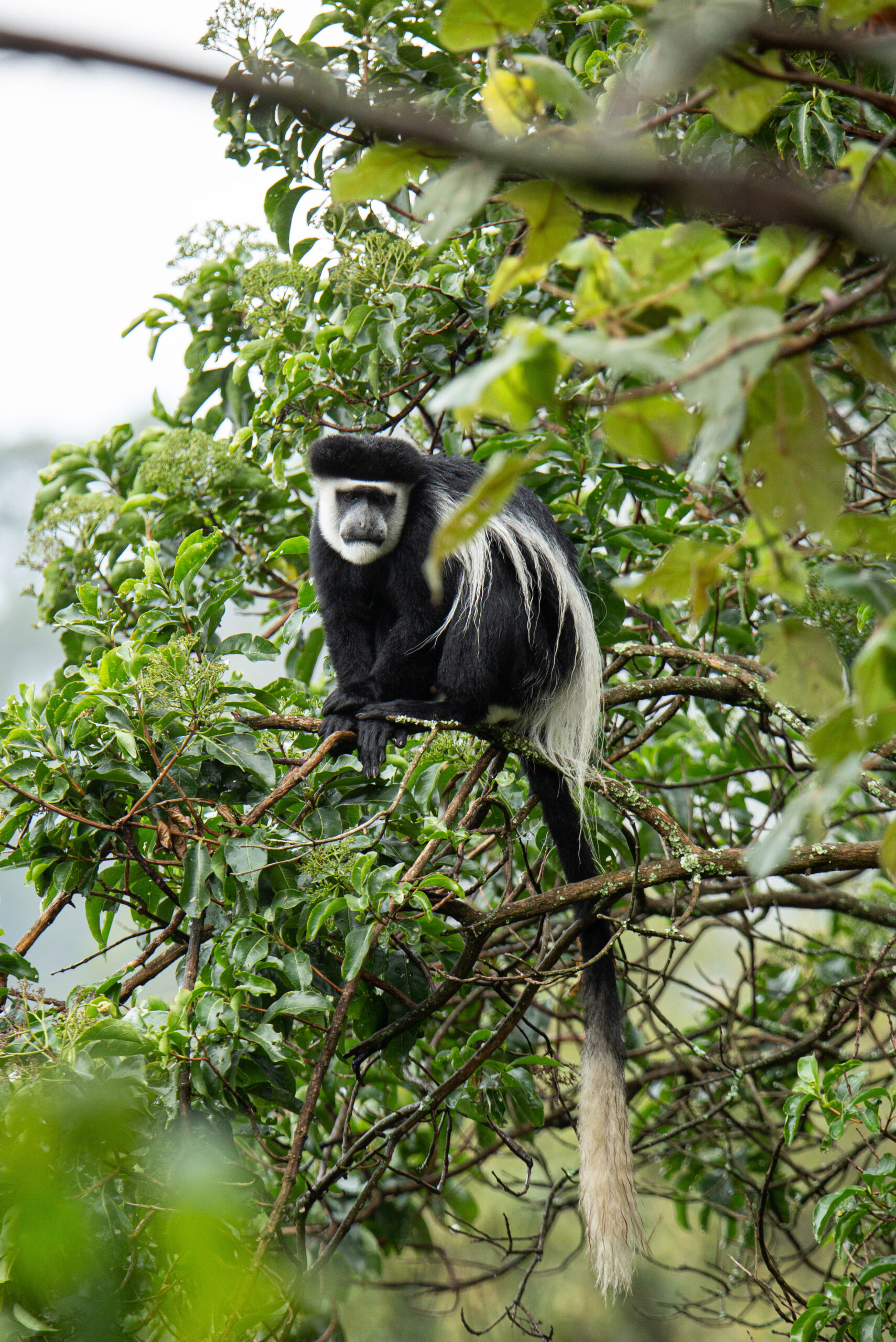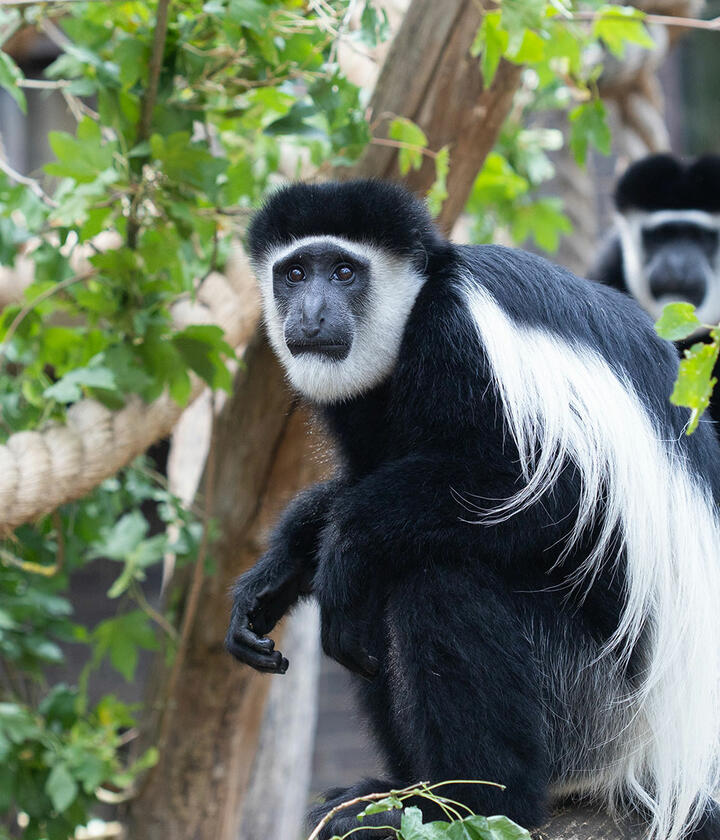
Black and White Colobus Monkeys
Black and white colobus monkeys, scientifically known as Colobus guereza, are captivating creatures that inhabit the lush forests of Africa. With their striking appearance and unique behaviors, these primates have captured the attention and curiosity of scientists and nature enthusiasts alike. Explore the intriguing world of black and white colobus monkeys, shedding light on their physical characteristics, social structure, habitat, diet, and conservation status.
Physical Characteristics:
Black and white colobus monkeys are medium-sized primates, characterized by their distinctive coat coloration. Their name derives from their black fur, accented with a mantle of long, flowing white hair that runs from their shoulders to their tail. This striking contrast serves as effective camouflage within the dense vegetation of their arboreal habitat. They possess a lithe, agile body, allowing them to navigate effortlessly through the treetops. Additionally, they have a prehensile tail, which aids in balance and gripping branches.

Social Structure and Behavior:
These monkeys exhibit a highly social lifestyle, living in groups known as troops. These troops typically consist of several individuals, including a dominant male, multiple females, and their offspring. The dominant male plays a crucial role in protecting the group from predators and other potential threats. Within the troop, social bonds are reinforced through grooming, vocalizations, and various forms of physical contact.
Habitat and Range:
The black and white colobus monkeys are native to the forests of Central and East Africa, including countries like Kenya, Uganda, Tanzania, and Ethiopia. They are arboreal creatures, spending the majority of their lives in the upper layers of the forest canopy. The dense forests provide them with abundant food sources, shelter, and protection from predators. Their nimble limbs and strong grasping abilities allow them to effortlessly move through the treetops, making impressive leaps from branch to branch.
Where can i see the black and white colobus monkeys in Uganda?
In Uganda, one of the best places to see black and white colobus monkeys is Kibale National Park. Kibale National Park is located in western Uganda and is known for its diverse primate population. It is home to a large number of colobus monkeys, along with other primate species like chimpanzees and red colobus monkeys.
Within Kibale National Park, there are several trails and forested areas where you have a good chance of encountering these monkeys. The most popular trail for primate viewing is the Kanyanchu Primate Walk, where you can join guided walks led by experienced park rangers who can help you spot and identify different primate species, including the black and white colobus monkeys.
Bwindi Impenetrable National Park: Situated in southwestern Uganda, Bwindi Impenetrable National Park is famous for its population of endangered mountain gorillas. While gorillas are the main attraction, the park is also inhabited by black and white colobus monkeys.
More places to see these monkeys
Mgahinga Gorilla National Park: Also located in southwestern Uganda, Mgahinga Gorilla National Park is part of the larger Virunga Conservation Area. This park is known for its mountain gorillas, but it is also home to black and white colobus monkeys.
Additionally, Queen Elizabeth National Park in western Uganda as well is another amazing place primarily known for its abundant wildlife. It is also home to black and white colobus monkeys in the forests reserves around it. Not forgetting, it has 3 forests reserve that include Kyambura Forest reserve, Kalinzu Forest Reserve and Maramagambo Forest.
Lastly, Murchison Falls National Park in the northern part of Uganda is known for its chimpanzees and other primates. In Budongo forest, you get to do chimpanzee tracking where you get to see other primates that include the black and white colobus monkeys. Exploring the forested areas of the park can provide opportunities for observing these fascinating creatures.

These national parks offer unique experiences for wildlife enthusiasts and provide opportunities to observe and appreciate the beauty of black and white colobus monkeys in their natural habitats.
It’s important to note that wildlife sightings can never be guaranteed, as animals are free-roaming and their movements can be unpredictable. However, Kibale National Park is known for its rich population of primates like chimpanzees, baboons and colobus monkeys among others. You will have a good chance of seeing black and white colobus monkeys on your visit there.
Diet:
The diet of these monkeys mainly consists of leaves, buds, fruits, and flowers. They have a specialized digestive system with a complex, multi-chambered stomach, enabling them to break down fibrous plant material efficiently. They possess a unique ability to ferment and extract nutrients from their high-fiber diet. This adaptation allows them to thrive on a predominantly herbivorous diet.
Conservation Status and Threats:
Unfortunately, these monkeys face several threats that have led to population declines in some areas. Habitat loss due to deforestation is one of the primary concerns for their survival. The destruction of forests for agriculture, logging, and human settlement has fragmented their habitat, limiting their range and access to food sources. Additionally, hunting for bush-meat and the illegal pet trade pose significant threats to their populations.

Conservation efforts, such as protected areas and community-based initiatives, play a crucial role in safeguarding their existence. These initiatives focus on habitat conservation, raising awareness, and implementing sustainable practices. The involvement of local communities and international organizations is vital in ensuring the long-term survival of these fascinating primates.
Conclusion:
Black and white colobus monkeys are captivating creatures that contribute to the biodiversity of the African rain-forests. Their unique coat coloration, social structure, arboreal lifestyle, and specialized diet make them intriguing subjects of study and observation. However, their survival is under threat due to habitat loss and human activities. By raising awareness, promoting conservation initiatives, and addressing the challenges they face, we can save them. We can strive to protect these remarkable primates and preserve their place in the intricate tapestry of our natural world.
You can book a primate safari with us.






